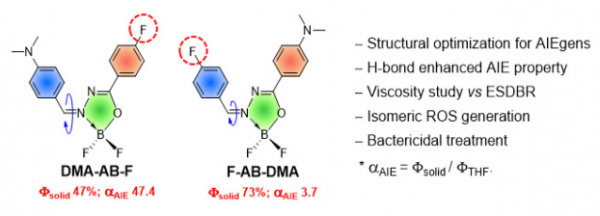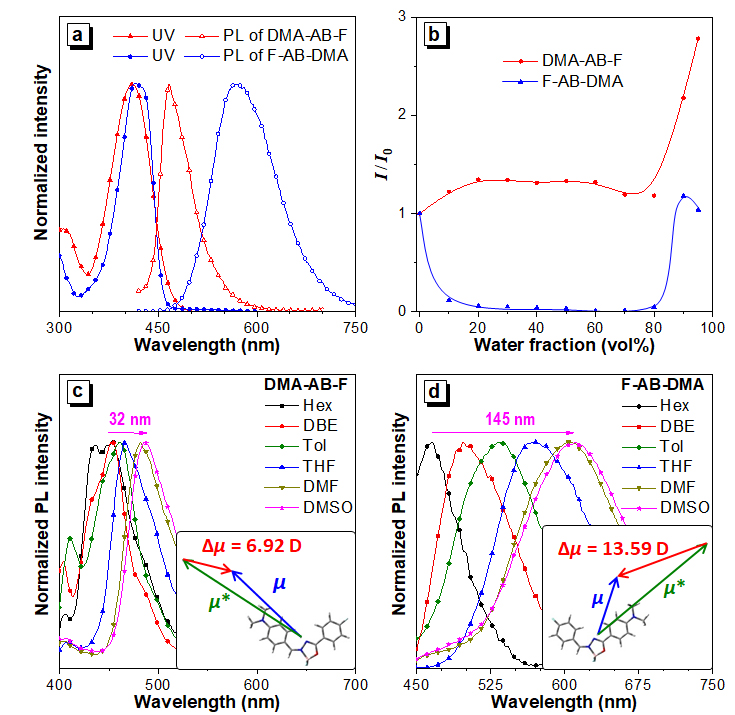A new study by Southern University of Science and Technology (SUSTech) has found a new form of luminescent material ideal for bacterial treatments that had previously shown themselves to be resistant to a broad range of drugs.
Department of Biomedical Engineering Associate Professor Li Kai led the research published in the high-impact journal Angewandte Chemie International Edition (Angew Chem Int Ed). The paper was titled “Planar AIEgens with Enhanced Solid‐State Luminescence and ROS‐Generation for Multidrug‐Resistant Bacteria Treatment.”
 Figure 1. The design strategy of fluorine replacing planar AIEgens
Figure 1. The design strategy of fluorine replacing planar AIEgens
Fluorescent materials have shown great potential in optoelectronics and biomedical engineering. However, one of the major flaws behind traditional fluorophores is that they suffer from aggregation-caused quenching (ACQ), a situation where the collection of fluorophores reduces the intensity of luminescence. The discovery of various types of aggregation-induced luminescent agents (AIEgens) provides a promising solution to address this challenge. However, it is still vital to find a simple and effective method to enhance solid-state luminescence of planar AIEgens, which would find significant commercial applications.

Figure 2. UV-vis and fluorescence spectra of planar AIEgens (DMA-AB-F and F-AB-DMA).
The research team designed and synthesized three pairs of planar AIEgens and studied their photophysical properties, intending to apply molecular engineering techniques to restrict the movement of the AIEgens in their aggregated state. Their results showed that they were able to inhibit their molecular movement and their non-radiative transition through the introduction of fluorine atoms to the aromatic ring. They hypothesized that the planar AIEgens they had developed would improve AIE performance and effectively promote the generation of ROS.

Figure 3. Antibacterial effect in vitro.
The research team tested the new AIEgens as photosensitizers against multidrug-resistant bacteria under a mouse model. In vitro testing (testing outside the body of a living organism) showed that their AIEgens would effectively kill MDR E. Coli and MRSA. In the follow-up in vivo testing on mice, they were able to show that their AIEgens would kill significantly more bacteria following photodynamic therapy than the control group.

Figure 4. In vivo antibacterial effect.
The study has proved a new direction in the treatment of multi-drug resistant bacterial infections through the use of reactive oxygen species expressed through the use of planar AIEgens. This unique approach provides more opportunities for researchers to develop a broad range of AIE photosensitizers for use in the biomedical industry.
Research Associate Professor Ni Jen-Shyang and masters students Min Tianling were the co-first authors. Associate Professor Li Kai was the correspondent author. The contributing units were the Department of Biomedical Engineering at SUSTech, the HKUST-Shenzhen Research Institute (SRI), and the Shenzhen Institutes of Advanced Technology, Chinese Academy of Sciences.
The authors are grateful to the National Natural Science Foundation of China, the Thousand Young Talents Program, and the Science and Technology Plan of Shenzhen for financial support. The authors also acknowledge the Center for Computational Science and Engineering at SUSTech for theoretical calculation support and SUSTech Core Research Facilities for technical support.
Paper link: https://onlinelibrary.wiley.com/doi/abs/10.1002/anie.202001103
Proofread ByXia Yingying
Photo ByDepartment of Biomedical Engineering